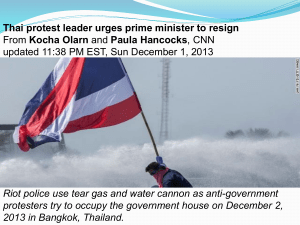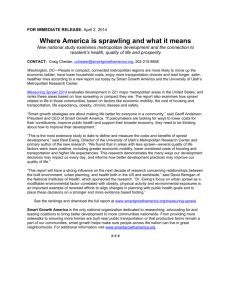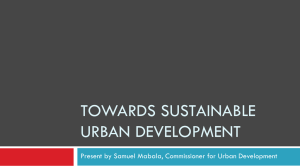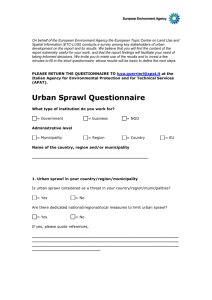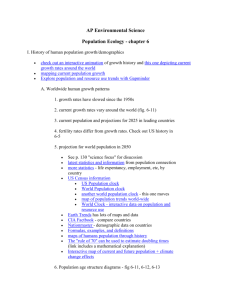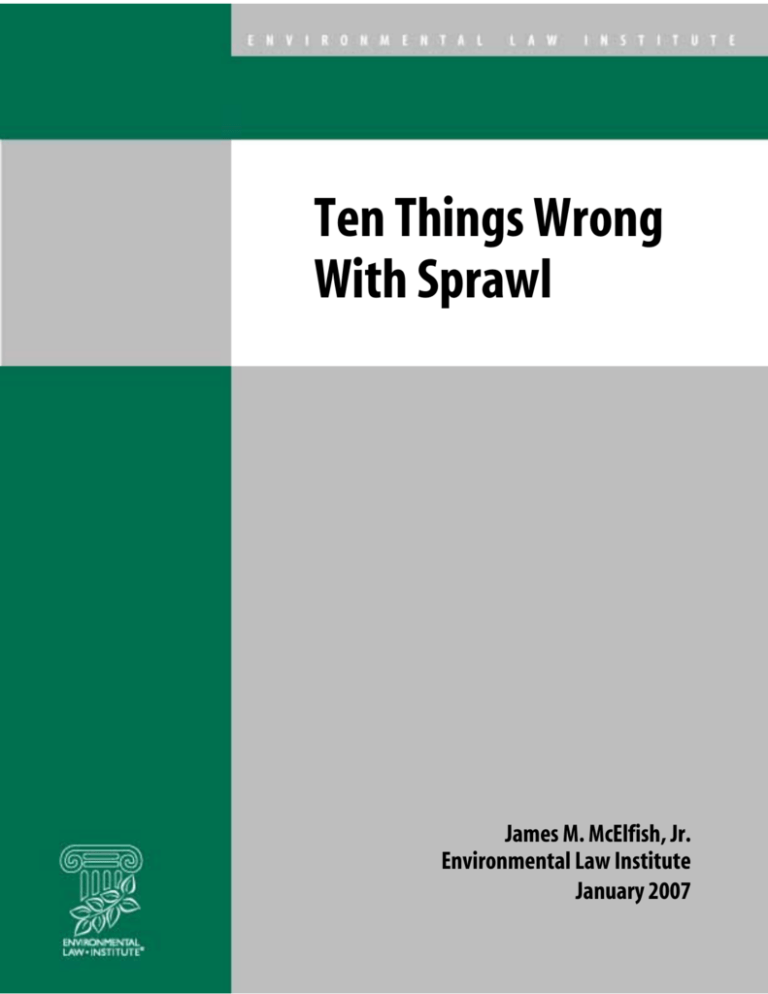
Ten Things Wrong
With Sprawl
James M. McElfish, Jr.
Environmental Law Institute
January 2007
Ten Things Wrong
With Sprawl
James M. McElfish, Jr.
Environmental Law Institute
January 2007
About ELI Publications—
ELI publishes Research Reports and briefs that present the analysis and conclusions of the
policy studies ELI undertakes to improve environmental law and policy. In addition, ELI
publishes several journals and reporters—including the Environmental Law Reporter, The
Environmental Forum, and the National Wetlands Newsletter—and books, that contribute to
education of the profession and disseminate diverse points of view and opinions to stimulate a
robust and creative exchange of ideas. Those publications, which express opinions of the authors
and not necessarily those of the Institute, its Board of Directors, or funding organizations,
exemplify ELI’s commitment to dialogue with all sectors. ELI welcomes suggestions for article
and book topics and encourages the submission of draft manuscripts and book proposals.
Ten Things Wrong With Sprawl
Copyright © 2007 Environmental Law Institute®, Washington, D.C. All rights reserved.
ISBN No. 978-1-58576-111-1, ELI Project Nos. 0621-01, 0621-02
An electronic retrievable copy (PDF file) of this report may be obtained for no cost from the
Environmental Law Institute Website www.eli.org, click on “ELI Publications,” then search for
this report.
[Note: ELI Terms of Use will apply and are available on site.]
(Environmental Law Institute®, The Environmental Forum®, and ELR® – The
Environmental Law Reporter® are registered trademarks of the Environmental Law Institute.)
Ten Things Wrong With Sprawl
by James M. McElfish, Jr.
Director, Sustainable Use of Land Program
Environmental Law Institute
In just the next thirty-four years, the
Census Bureau tells us, we 300 million
Americans will be joined by another 92
million.1 Where will all these people –
mostly us and our direct descendants – live,
work, play, worship, buy, sell, and serve?
Where will 40 million additional
households be located? What sort of built
environment will we produce, and what will
be the results for the nation’s and the
environment’s well-being?
The prevailing form of land development
is popularly known as sprawl or exurban
sprawl.2 Sprawl is characterized by low
density development that rigorously
separates residential uses from other land
uses, and that relies entirely or almost
entirely on automobile transportation to
connect the separate uses. There are strong
reasons to prefer that the nation’s future
development does not reproduce this
pattern -- reasons that have nothing to do
with the price or availability of gasoline.
Urban planning professor Jonathan
Barnett, in his book The Fractured
Metropolis, charges sprawl with overconsumption of resources, risks to the
natural environment, and loss of
community resulting from the time
demands imposed by the physical
separation of commercial, business,
residential, and social land uses.3 Economic
critics of sprawl emphasize the high costs of
duplicated infrastructure, the cost of time
devoted to delays in commuting, and the
distortions resulting from the mismatch
between initial economic benefits of
construction in sprawl areas and the costs
of meeting subsequent demands for services
(schools, roads, fire and police) by these
same areas.4 On environmental grounds,
opponents of sprawl decry the rising
amount of land conversion per each unit of
new development (more acres per person),
the paving over of some of the nation’s
highest quality farmland, and losses of
biological diversity and open space.5
Sprawl enthusiasts counter that people
are getting what they want in low density
housing and ubiquitous shopping, that a
rising population will need more housing
on cheap land, and that commute times,
while rising, are not that bad for most
people. They emphasize the number of
construction jobs created and the higher
assessed land value of developed lands over
agricultural and forest lands.6 Sprawl
enthusiasts downplay the agricultural land
issue by suggesting that America still has
large areas of land suitable or at least
potentially suitable for agriculture (there is
no “food shortage”), while further noting
that the direct contribution of agriculture to
the nation’s gross domestic product is
modest in comparison with other economic
sectors.7
Many of these arguments talk past one
another. For example, well-paying
construction jobs need not depend upon
future construction in sprawl patterns
rather than in alternative forms of
development. Ninety-two million more
people will need somewhere to live and
work and go to school, after all. Likewise,
the arguments over agricultural lands are
not really about whether food will run out,
or even whether commercial retail buildings
generate more net economic value than
1
crop lands (a hotly disputed topic, by the
way), but rather whether the location of
agriculture, forests, retail and housing
matters. Arguments about traffic and travel
times often gloss over whether alternative
development patterns and transportation
options can deliver comparable flexibility
with fewer side effects.
Whatever one thinks of these arguments
and their critique of past practices and the
current built landscape, at least when
considered prospectively, sprawl has ten
undeniably adverse effects that should place
it on the public policy agenda.
1. Sprawl development contributes to
a loss of support for public facilities and
public amenities. In economic terms,
sprawl encourages market failure; residents
of sprawl communities have access to public
facilities that they do not support with their
tax dollars, and residents of older
communities subsidize the existence of the
these facilities.
Sprawl communities typically lack parks,
museums, civic spaces, libraries, and the
like. This frequently occurs either because
some of these amenities are privatized and
made available only to a small segment
(owners of large lots have less need for
public open space), or because sprawl
dwellers can be “free riders” on urban
facilities supported in substantial part by
others. Pittsburgh city officials have noted,
for example, that their city’s land base
includes substantial tax exempt properties –
museums, universities, parks, hospitals,
libraries, zoos – far in excess of those in
suburban jurisdictions whose citizens can
enjoy city facilities while also benefitting
from lower suburban tax rates.8 In many
communities, property taxes in the exurbs
are lower than those in the cities because of
this mismatch.
In most metropolitan areas, piecemeal
construction of new subdivisions does not
include community centers and public
2
facilities. The nearest thing to civic spaces
in sprawl communities are the stone gates
flanking the entrance sign. And when there
are common spaces, they are often
restricted to the members of homeowners’
associations. There are weak or nonexistent
social and financial ties to the support of
regional facilities of general public benefit,
such as public hospitals and parks.9
2. Sprawl undermines effective
maintenance of existing infrastructure.
Existing developed areas – cities and older
suburbs – have sewers, water systems, city
streets, bridges, schools, transit systems
and other hard infrastructure to maintain.
But exurban development draws population
away from areas with existing
infrastructure and into new areas where
new infrastructure must be constructed or
where some infrastructure costs are
avoided, at least temporarily, through the
use of wells and septic systems, or by
reliance on undersized roads that are
upgraded at great public expense long after
the developments have been constructed.
The frequent result is a shift of population
regionally, leading to a decline in the urban
and older suburban tax base. This decline in
turn prompts increases in urban taxes and
rates (needed to support the existing
infrastructure across a smaller population),
and/or to deferral of maintenance activities.
Both of these effects further disadvantage
the existing systems and encourage further
exodus. John Fregonese, the Region 2040
lead planner for Portland’s Metro
government makes this point, “When you
have sprawl, all your resources are sucked
to the edge for new roads, and schools and
sewers. Then you have a lack of money for
rebuilding...and you get these rotting
cores.”10
3. Sprawl increases societal costs for
transportation. Costs rise largely because
of the need for expensive retrofits. Typical
scenarios include the conversion, after
sprawl has occurred, of exurban two lane
roads to four lanes or six lanes, adding
signals, construction of grade separations
for intersections, and building county or
intercounty connector highways and
metropolitan belt roads. This invariably
occurs at great expense and disruption –
because of increased right-of-way costs,
difficulties in maintaining traffic flow
during the construction period, and often
substantial community opposition.
This retrofit dilemma is a spin-off of the
problem of traffic. People hate traffic – in
fact, part of the reason for sprawl is the
elusive promise that commuters and
commercial offices can outrun traffic by
continually expanding into lower traffic
areas. And, at least initially, average
commute times are generally lower within
sprawl areas than commutes from sprawl
areas to the center city. But traffic is, in
general, extremely bad in sprawling
metropolitan areas – often worse on
weekends when travel is more diffuse and
timing strategies intended to avoid peak
travel times do not work. Catch-up
transportation expenditures have to be
made.11
Unfortunately, often they can’t be made.
For example, consider the sprawl area
north of Chicago. Like many suburban
papers, the local newspaper in Lake County,
Illinois, has a daily “roads” column. A fairly
typical letter printed in the column
bemoaned the daily backups at the
intersection of a heavily traveled two-lane
road with a four-lane highway. The Illinois
DOT spokesman contacted by the paper
responded that the intersection complained
of had been completely upgraded and reengineered only a few years earlier. It had
already been overtaken by increased traffic
flow. The spokesman commented that there
was no remaining engineering or right-ofway expansion solution on this road, so the
only thing that IDOT could do would be
new re-construction projects on parallel
routes. The retrofit problem is a perennial
feature of sprawl, as any sprawl dweller can
personally attest, and its costs are high.
4. Sprawl consumes more resources
than other development patterns.
Because homes, offices, utilities, and other
features are farther apart (requiring more
asphalt, more lengths of pipe, more
conduits, more wires), because each
commercial and institutional structure
requires its own acres of parking, and
because much of the utility infrastructure is
duplicative of the “stranded” infrastructure
in nearby older communities – society’s
overall consumption of metal, concrete,
asphalt, and energy is higher.12
5. Sprawl separates urban poor people
from jobs. Ownership of an automobile
and the resources to maintain it are
essential for work in the suburbs, the site of
most new jobs in the modern economy.
However, the prevailing sprawl model of
development drastically separates different
price levels of housing from one another, as
well as separating job areas from residential
areas. These characteristics of sprawl mean
that locating new affordable homes near
jobs is quite difficult, and sprawl
consequently reduces the availability of jobs
for those in urban areas that lack reliable
automobile transportation.13 Overcoming
sprawl patterns could result in either
increasing the number of workplaces in
urban areas, or making it easier to construct
and maintain the availability of affordable
housing near workplaces.
6. Sprawl imposes a tax on time.
Sprawl development requires that we spend
more time on the road. Exurbia, including
most post-war suburbia, rigorously
separates residential housing, food stores,
other retail establishments, warehouse and
transfer facilities, industry, schools, and
3
office buildings. This has adverse effects on
neighborhoods, and leads to more
automobile travel. In exurban areas,
commercial establishments can be accessed
only when people drive to each location.
Nonwork automobile trips now comprise
more than 80 percent of all daily trips.14
Residents of sprawl areas do not forego the
benefits of mixed uses of land, but they pay
a price in time, and they lack choice in their
mode of travel. Describing Tyson’s Corner
outside Washington, D.C., where offices
and commercial buildings are completely
separate from any residential housing and
all access is via main arterial roads, a
Washington Post writer noted that “a sixmile commute home can stretch to 90
minutes.”15 Sprawl also makes it take much
longer for the one-third of Americans who
reside in central cities and inner ring
suburbs16 to get to greenfields areas for
recreation and enjoyment. Sprawl, in effect,
imposes a hidden tax on time by making
certain amenities more remote and harder
to reach.
7. Sprawl degrades water and air
quality. Sprawl development is hard on
streams, wetlands, and runoff quality. It
reduces the resilience of streams and other
waters by degrading headwaters and
impoverishing habitat. For example, in the
Chesapeake Bay region, sprawl is the
largest threat to water quality. It increases
the area of impervious surface, decreases
retention time for rainwater and diminishes
its infiltration into the soil and water table,
and it leads to rapid erosion and structural
degradation of streams and rivers, which
therefore receive runoff in much greater
volumes in a shorter period of time.17 It also
increases the frequency and intensity of
flooding, placing further demands on the
public treasury for preventive structures
and disaster response.18 In metropolitan
areas, air pollution can be worse over a
much larger area. Vehicle miles traveled as
4
well as time sitting in traffic rises
significantly in these mega-sprawl areas; for
example, motorists in the Atlanta area log
about 100 million miles per day with 2.5
million registered vehicles.19 Another effect
related to sprawl development patterns is
the loss of a constituency that can be served
by transit or other means. Residents’
inability to substitute other modes for the
automobile, including walking and transit,
is an undeniable drag on every area’s ability
to meet clean air goals.20
8. Sprawl results in the permanent
alteration or destruction of habitats.
Sprawl development converts large areas to
asphalt, concrete, and structures, altering
the landscape hydrology and reducing the
biological productivity and habitat value of
the land.21 While any conversion of open
lands to developed uses can impair the prior
environmental values and there will always
be tradeoffs to accommodate human needs,
sprawl development does so at a high rate
of land conversion per unit of
development.22
A related problem is the loss of
productive farmland near metropolitan
areas. This feature of sprawl development
has been documented in persuasive detail by
the American Farmland Trust through
repeated studies under the rubric of
Farming on the Edge.23 Farmland
contributes at least incidentally to wildlife
habitat and potential for future restoration.
Although there is, at least in the near term,
no threat to the nation’s total food
production given the amount of remaining
farmland, as well as farmland currently
fallowed under federal conservation and
price stabilization programs, the loss of
prime farmland is not desirable from the
point of view of long term uses.
Conversion of land near urban areas also
presents an environmental loss in the sense
that dense urbanization places stresses on
habitat and aquatic systems that can best be
offset by the beneficial effects of retaining
larger tracts of nearby vegetated open space
in the same watershed and habitat areas.
Without this open space (farms, forests),
metropolitan areas and their adverse
environmental effects are unbuffered.
9. Sprawl creates difficulty in
maintaining community. People do have
communities in their suburban
neighborhoods, workplaces, and in their
organized activities. Modern day exurbs are
not the places of alienation described by
some “new urbanist” writers, many of
whom draw upon affection for the older
urban neighborhoods of the early and mid20th century.24 But these new sprawl
communities require more driving, and
more complicated arrangements to
maintain social connections. This also
means that children are at the mercy of
scheduled activities and “play dates” rather
than neighborhood interactions, and
exercise becomes an isolated activity on the
schedule, rather than a natural consequence
of walking, biking, or using public park
facilities. These demands exact a social toll.
Planner William Fulton recently described
the effect of sprawl in the greater Los
Angeles area as “a constant caravan
between the residential cocoon, where
citizenship is exercised only in narrow, selfinterested ways, and the spending and
working cocoons, where citizenship is
totally surrendered to the commercial
forces that run the place.”25
10. Sprawl offers the promise of
choice while delivering more of the
same. In America, choice is not only a
cherished value, it is also something that
our market economy claims as its highest
achievement. But, paradoxically, we have
lost choice in our system of development.
Sprawl constrains our choices. If you want a
new house, you can have one on a half acre
in the suburbs with no retail around. If you
want to locate a store or an office, the
arterial strip or highway interchange is for
you. If you want transportation, you can
use your car. If you are poor you can live in
substandard housing in the inner city or
manufactured housing on the farthest
fringes of the metropolitan area. This lack
of choice is why every part of exurban
America resembles every other part.
***
Portions of the building industry
sometimes say that our current development
patterns perfectly reflect the satisfaction of
American social demands. Whatever we
have, whatever we are creating, it must be
what we want, or the market would provide
something else. However, this position
requires us to deny the influence of laws,
institutions, zoning codes, financing rules,
government subsidies and market failures.
Much of the sprawl we see is the
unintended result of laws and policies that
were imperfectly aimed at something else,
such as easing transportation delays,
encouraging school modernization,
providing healthy settings for housing, or
stimulating home ownership.
We will only be able to address these
mismatches of law and policy, and to root
out perverse unintended consequences, if we
recognize that something is amiss with our
current patterns of development.
Some things really are wrong with
sprawl. “We need to find a better word,” said a
builder representative to a program on
smart growth in which I participated a few
years ago. Well, that’s one approach. But a
better approach is recognizing that we have
real problems ahead if current development
patterns continue to prevail. Only such
recognition will enable us to take steps to
reform the laws and policies that hold us
back – and enable us to find places and
provide choices for our 92 million new
neighbors.
5
ELI’s Sustainable Use of Land Program and
its projects are supported by the Heinz
Endowments, the William Penn Foundation,
the Keith Campbell Foundation, the Abell
Foundation, Douglas Keare, and others. The
Institute is solely responsible for the content of
this publication.
Notes
1.http://www.census.gov/ipc/www/usinterimproj/ The
projection for 2040 is 392 million. Current U.S.
population is 300 million.
2. Exurban means “outside the city.” It is a more
accurate term for today’s sprawl areas than
“suburban,” as many sprawl areas have little direct
economic or social connection to the cities in whose
regions they lie. Their job centers are not in
downtowns but in other exurbs.
3. Jonathan Barnett, The Fractured Metropolis
(1995), pp. 6-7.
4. Real Estate Research Corporation, The Costs of
Sprawl: Environmental and Economic Costs of
Alternative Residential Development Patterns at the
Urban Fringe (1974); Sierra Club, Dark Side of the
American Dream: The Costs and Consequences of
Suburban Sprawl (September 9, 1998); James E.
Frank, The Costs of Alternative Development
Patterns: A Review of the Literature (Urban Land
Institute, 1989); Clint Yuhfill, The Invisible
Economics of Real Estate Development,
(Pennsylvania Environmental Council 1994); Robert
W. Burchell, et al., The Costs of Sprawl-Revisited:
Transit Cooperative Research Program Report 39
(Transportation Research Board, National Research
Council, National Academy Press, 1998).
5. See e.g., American Farmland Trust, Farming on the
Edge (1997)(America is rapidly losing high quality
farmland to development); Reid Ewing and John
Kostyack, Endangered by Sprawl: How Runaway
Development Threatens America’s Wildlife (National
Wildlife Federation, Smart Growth America, Nature
Serve: Washington, DC: 2005)(sprawl is fragmenting
and degrading habitat).
6. See e.g., Peter Gordon and Harry W. Richardson,
“Are Compact Cities a Desirable Planning Goal?”
Journal of the American Planning Association, Vol.
63, No. 1, Winter 1997; Peter Gordon and Harry W.
Richardson, “Critiquing Sprawl’s Critics,” Policy
6
Analysis (Cato Institute, Jan. 24, 2000); Randall G.
Holcombe, “In Defense of Urban Sprawl,” PERC
Reports, February, 1999. Roberta Maynard, “The
Ripple Effect,” Builder magazine, July 1998 (“Each
new home build in America is like a mighty
economic engine...”). Of course, developed lands also
usually require substantial municipal services, and the
net economic outcome from a municipal finance point
of view is often negative. See American Farmland
Trust, Living on the Edge: Costs and Risks of Scatter
Development.
7. Samuel R. Staley, The Sprawling of America: In
Defense of the Dynamic City (Reason Public Policy
Institute, Policy Study No. 251, 1999)(“Urban
development does not threaten the nation’s food
supply”), Gordon and Richardson, supra, n. 6
(“America is not running out of open space.” And
“Detailed economic data suggest that the direct
contribution of agriculture to the nation’s economy is
modest” in contrast with manufacturing and other
uses of the land.)
8. See, e.g., Timothy McNulty, “Tax-exempt
properties are killing city financially, controller
Flaherty says,” Pittsburgh Post-Gazette, Jan. 13,
2000.
9. William Fulton, The Reluctant Metropolis: The
Politics of Urban Growth in Los Angeles (Solano
Press Books: Point Arena, California, 1997).
10. Dee Hall, “The Choice: High Density or Urban
Sprawl - Portland Area Gets Creative to Control
Growth, Wisconsin State Journal, July 23, 1995.
11. D Schrank & T. Lomax, The 2005 Urban
Mobility Report (Texas Transportation Institute,
2005) (constructed road capacity must increase faster
than increases in travel if increases in congestion
delays are to be prevented, but this has not occurred
in the 85 metropolitan areas studied; indeed only four
had a narrow gap).
12. Funders’ Network for Smart Growth and Liveable
Communities, Energy & Smart Growth: It’s About
How and Where We Build (2004), avail. at
http://www.fundersnetwork.org/usr_doc/Energy_and
_Smart_Growth.pdf
13. The research confirming this effect is summarized
in Margaret Pugh, Barriers to Work: The Spatial
Divide Between Jobs and Welfare Recipients in
Metropolitan Areas (Brookings Institution, Sept.
1998). See also Robert Cervero et al., “Job
Accessibiity as a Performance Indicator: An Analysis
of Trends and Their Social Policy Implications in the
San Francisco Bay Area,” Institute for Urban
Regional Development, Univ. of Cal. at Berkeley
(1997). The National Association of Home Builders
argues that the job gap is a reason to support sprawl:
build where the jobs are. “Sierra Club Report on
Growth is Flawed and Biased, NAHB Says”, NAHB
Press Release, Sept. 9, 1998.
14. Surface Transportation Policy Project, High
Mileage Moms (1999) (only 18 percent of automobile
trips are commuting to work), available at
http://www.transact.org/report.asp?id=184.
23. American Farmland Trust, Farming on the Edge
(1997).
24. E.g. James Howard Kunstler, The Geography of
Nowhere (1993)(a well-written jeremiad including
riffs on the alleged alienation of exurbia).
25. William Fulton, The Reluctant Metropolis: The
Politics of Urban Growth in Los Angeles,” (Point
Arena, California: Solano Press Books, 1997), pp.
343-344.
15. Alice Reid, “Tysons Growth Revs Up Concern
About Gridlock,” Washington Post, March 13, 1999.
16.Robert Puentes and David Warren, One-Fifth of
America: A Comprehensive Guide to America’s First
Suburbs (Brookings Institution, Feb. 2006), at 6.
17. See e.g., Paul Nussbaum, “Paving way for
environmental harm,” Philadelphia Inquirer, Feb. 9,
1999 (recounting water quality impacts of
development in exurban areas surrounding
Philadelphia). Dana Beach, Coastal Sprawl: The
Effects of Urban Design on Aquatic Ecosystems in
the United States (Pew Oceans Commission,
2002)(summarizing scientific research).
18. Rutherford Platt, et al., Disasters and Democracy
(Island Press, Washington, D.C. 1999).
19. Robert D. Bullard, Glenn S. Johnson, and Angel
O. Torres, “Atlanta Megasprawl,” Forum for Applied
Research and Public Policy, vo. 14, no. 3, Fall 1999,
p. 17, 19.
20. Environmental Protection Agency, The
Transportation and Environmental Impacts of Infill
Versus Greenfield Development: A Comparative
Case Study Analysis (Washington, D.C., 1998).
21. Reid Ewing and John Kostyack, Endangered by
Sprawl: How Runaway Development Threatens
America’s Wildlife (National Wildlife Federation,
Smart Growth America, Nature Serve: Washington,
DC: 2005); Bruce Stein, L.S. Kutner, J.S. Adams,
Precious Heritage: The Status of Biodiversity in the
United States (Oxford U. Press: New York: 2000).
22. See generally, James M. McElfish, Jr., NatureFriendly Ordinances (Envtl. L. Inst. 2004).
7
F
or more than three decades, the
Environmental Law Institute has
played a pivotal role in shaping
the fields of environmental law,
management, and policy domestically
and abroad.Today, ELI is an internationally recognized, independent
research and education center.
Through its publications and
information services, training courses
and seminars, research programs and
policy recommendations, the Institute
activates a broad constituency of
environmental professionals in
government, industry, the private bar,
public interest groups, and academia.
Central to ELI’s mission is convening
this diverse constituency to work
cooperatively in developing effective
solutions to pressing environmental
problems.
The Institute is governed by a board
of directors who represent a balanced
mix of leaders within the
environmental profession. Support for
the Institute comes from individuals,
foundations, government, corporations,
law firms, and other sources.
Environmental Law Institute
2000 L Street, N.W., Suite 620
Washington, D.C. 20036
Telephone: (202) 939-3800
Fax: (202) 939-3868
www.eli.org


